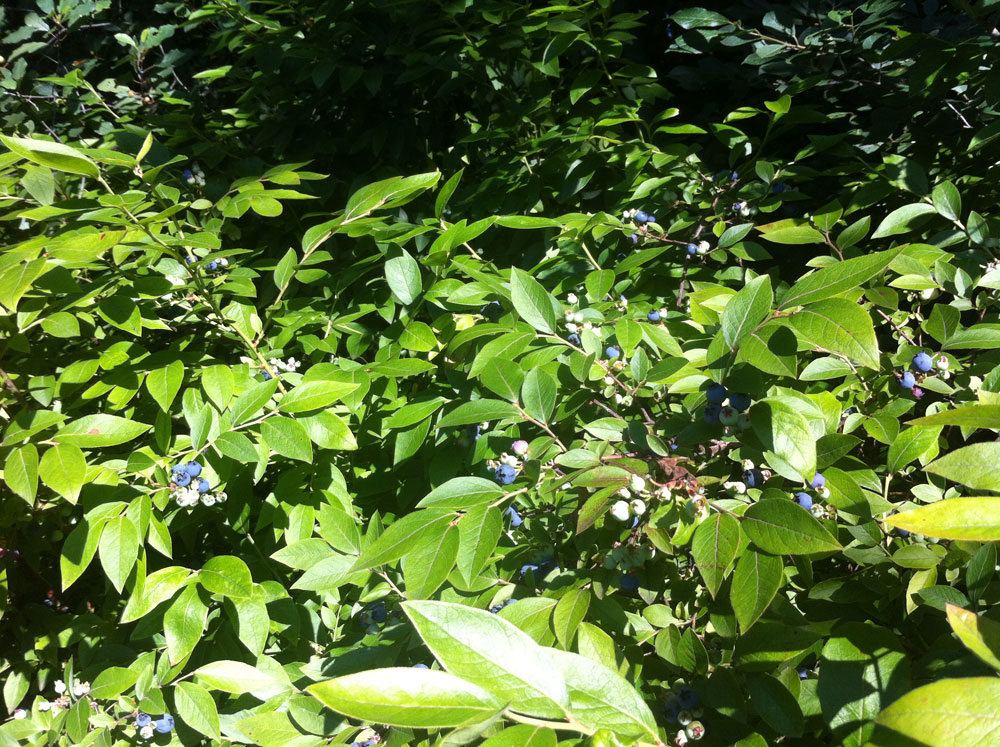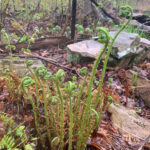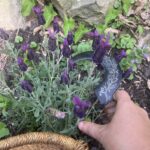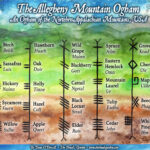This is my second in a two-part series on how to wildcraft and forage successfully. The first post dealt with supplies for foraging, resources and how to learn the skills, and understanding timing. This post will talk about places to gather, avoiding contaminants in the landscape, the ethics of harvesting, and the spiritual side to foraging and wildcrafting.
Also note that I now offer free graphics for ethical wild food foraging, teaching foraging, and sharing with others (licensed under creative commons). Get them here!
Where You Gather: Kinds of Property

Wildcrafting obviously requires you to go out into the land and find what you need. There are different kinds of places you can go—your own backyard/land, parks, abandoned lots, friends’ land, and so on. Each location has some benefits and as you start wildcrafting and foraging, you will find your own spots that you will return to again and again and again. Here are some of the kinds of places that I go:
My own land. Since I know it best and am out there every day, I can observe the changing landscape as the seasons pass. I know the history of the land, I know how much of a particular plant is usually in season, and I can know how much to ethically take since I’m the only one taking. So obviously, if you have your own land, this is a wonderful place to harvest. A lot of people don’t have access to some acreage, however, and this leads us to….
Friends/Neighbors/Family Private land. If you can’t harvest on your own land, or don’t have your own land, finding another private land (such as that of friends, family, or neighbors) you can harvest from is really a great thing. You can ask them about the land’s history; you can harvest without anyone else around, you can know just how much to take, and you can share the joy and abundance of the harvest with others. I have found that if I approach a friend or neighbor about wildcrafting from their land, they are often not only willing to let me onto their property but also interested in learning more (and yes, this often even works with complete strangers!) This creates a space to teach them about the sacred medicine of their own landscape, which only deepens their appreciation for the land. I have also found that for those who already value their land, they love it when you appreciate and value it also. For example, there is a spot I harvest cattails from along a road for making paper each spring, and a couple walking there had the land across the street. They asked me what I was doing, and I told them, and they invited me into their property. I was not only able to gather more cattails there, but also found a bunch of recently dropped willow branches to make a basket and some cattail shoots for making a nice stir fry. They were excited to learn about their property and invited me to come back anytime. I’m reminded here of my 85-year-old neighbor who has an 80-acre farm; we tap trees, harvest apples, forage for herbs and berries, and so much more there—and he’s so happy that someone else values it.Of course, one does need to be careful of who one asks—some people just don’t want others on their property. There also might be a gender bias in this—my good friend, who I harvest with often, says that people are much more likely to say yes to me than to him alone (he has long hair and a beard and maybe he looks a little unscrupulous).
Public lands. Not that long ago, the idea of a “common” land (or “the commons”) was quite a strong one. However, in the 20th century, that idea largely shifted and now the emphasis is on pristine preservation (Wendell Berry discusses this concept much further in The Unsettling of America: Culture and Agriculture). The idea is that the land will be soiled if someone takes something from it—and this is true, in a manner of speaking, because few people today know how to harvest and take ethically. Yet these intensive obsessions with pristine preservation sit side by side with the push to sell of public lands, to allow logging, mineral rights, fracking, and more. These are all products of industrialization–the disconnection of people with the land, the commodification of goods and wealth into the hands of the few. So when one enters public land, one needs to be aware of the laws surrounding that land. If you are to take nothing, take nothing. A lot of state and local parks have this kind of arrangement–do not take anything. However, most state game lands function more like the old commons—you can limited amounts of game, you can cut limited amounts of firewood, you can pick mushrooms, and so on—and they are great places to wildcraft. Many local parks, likewise, have no laws against harvesting. However, to be an ethical harvester you do need to be aware of overharvesting, of chemicals, the history of the land, and so on.

Where You Gather: Kinds of Ecosystems
In addition to the kinds of property that you are gathering from, you also want to think carefully about what ecosystems you will be gathering from. For example, a swamp or marsh is simply going to have a different ecosystem and plants than a deep secluded forest or an abandoned farm field. This is why I mentioned I have several “spots” that I like to go to–many of them with multiple ecosystems. Another thing to think about, stemming from permaculture design, is understanding the value of the edges and margins. That is, the edge where the forest meets a field is often a very rich and diverse ecosystem.
Here is just a short list of where I find what plants that I gather to give you a sense of this:
- Edge of Pond/Lake/Near Water: blueberries (in a bog); highbush cranberries (edge of a bog); horsetail (medicinal, edge of lake where there is a sandy soil), beach plums (beach on great lakes), cattail (edge of pond, swampy areas), boneset (edge of water, medicinal), marshmallow (edge of water, medicinal), joe-pye weed (in shade or swamp, medicinal)
- Edge of Forest: black raspberries, red raspberries, blackberries (all edibles), mulberry trees (edible), stinging nettles (edible and medicinal), staghorn sumac (medicinal; also good for smoking blends), autumn olive (edible), violets (edible, medicinal), poke (medicinal, great dye plant), dryad’s saddle mushrooms (edible),
- Deep in the Forest: black birch (medicinal); chicken of the woods mushroom (edible), reishi mushroom (medicinal), blueberries (bush style, edible), maple sap (edible), acorns (edible), hen of the woods mushroom (medicinal/edible), stoneroot (medicinal), mayapple (edge of forest, edible), ramps (edible, over-harvested so only gather if they are abundant)
- Fields/Wastelands: St. John’s Wort (medicinal), goldenrod (medicinal), milkweed (edible), yarrow (medicinal), scrub red pine trees (resin for incense making), blackberries (edible), elderberries (medicinal/edible), new england aster (medicinal), dandelion (medicinal/edible), burdock (medicinal/edible)
- In the Suburbs/Landscapes: walnut (edible, medicinal), serviceberry (edible), various crabapples (edible), various other crab fruit trees planted as decorative (edible), eastern white cedar (often planted as an ornamental; medicinal and for smudges); plantain (medicinal, be careful the lawn wasn’t sprayed)

Now I think the above categories are fairly self-explanatory, all except the last one. The suburbs, the exurbs, the little strips of plant life along the strip mall, in the cities, etc., are typically NOT prime foraging grounds. Primarily this is because of pollution (see next section). However, people sometimes plant really nice trees there—various crab apples and serviceberries (and serviceberries are WELL worth finding and making into jam and baked goods). One of my favorite serviceberry spots is literally at the start of this posh subdivision, about 30′ back from the road. Another favorite serviceberry spot is in the parking lot of the library…you get the idea :). So while there are limited foraging to be done in the city and suburbs, fruit is one of your best bets. Tree fruits are also one of your best bets because trees are rarely sprayed where things on the ground, like plantain or dandelion, are usually heavily sprayed.
Toxins, Chemicals, and Pollution
If you are harvesting anything for internal use (medicine, edibles), you want to be aware of any chemical toxins in the landscape or area you are harvesting from. Toxins are not always easily to spot and can reside invisibly in the soil, so it takes some creative thinking and sleuthing to understand what may or may not be safe to eat.
Around houses and buildings. Soil near foundations of older houses and buildings often has lead because lead paint was used at one point and flaked off. You don’t generally want to harvest anything next to an older house that will be eaten (or plant anything, for that matter, that you are going to eat). Obviously, any factory sites are really off-limits for foraging.
In Swamps/Wetlands. Roots can often concentrate toxins and chemicals, and roots in swampy areas or lakes are particularly suspect. Remember that plants like Cattail function as the cleansing plant for a water system–this means if there are toxins, they are going to be heavily concentrated in the cattail plant roots. So, if you are harvesting roots or edibles, especially in swampy areas, look for the nearest body of water and see what is sitting upstream (like a polluting factory). Even in what appears to be a pristine swamp or wetland, you might not realize that a factory 10 miles up the river is dumping into the waterways. Using maps (and especially online maps) is really helpful for this. This is why I like to harvest cattails and other such roots and tubers from private lands that I have vetted well and from very small wetlands.
Pesticides, Herbicides, and other Sprays. There is also the issue of home and agricultural pesticides, herbicides, and fertilizers. While most tree medicine is off the ground, I would not harvest anything on the ground a subdivision where everyone poisons their lawns with chemicals weekly. Likewise, I would not harvest too close to any industrialized, conventional agriculture (e.g. huge fields of corn or soybeans or other chemically sprayed and GMO crops). These fields are covered in chemicals and those chemicals can easily drift to the surrounding landscape. And this sometimes sucks, because the best stand of staghorn sumac I know is right in front of an industrialized agriculture soy/corn field. Alas, that’s how it goes sometimes.
History of the Land. It’s also really useful to know the history of the landscape. If there used to be a factory that is now abandoned and torn down, you may not want to harvest there. This is actually one of the biggest impediments to urban farming in places like Detroit–so much of the land was poisoned with factories that people aren’t sure if it’s safe to grow in their soil. Regardless, use your common sense and intuition to figure out where is safe to harvest.
The Ethics of Wildcrafting/Foraging: Taking and Giving Back
Ethics are another area of concern to the forager and wildcrafter. Why? Because in the last 150 years, humans have done a very good job at taking and taking and not a very good job of giving back. And as I mentioned in part I of this series of posts, humans have largely lost our understanding of the ecosystem, knowing how to live in balance from the land. Most of us live completely disconnected from it, and we haven’t developed an innate understanding of the land’s rhythms or ways.

Understanding Abundance and Scarcity. One of the first things that is important to understand from an ethical standpoint is the concepts of abundance and scarcity. There are, at times, great amounts of abundance in the landscape. There are also times of great scarcity (e.g. winter, less abundant seasons, droughts). When things are abundant, we must remember that we are not the only ones who depend on that abundance and that whatever we take is being taken from others that may need it for sustenance. This is why I so strongly suggested in my first post that you begin learning how to forage or wildcraft by understanding ecology. Even if things are very abundant, you want to limit what you take.
How much to harvest: the 30% guideline. I use the 30% rule for most harvesting of non-endangered, very abundant, native plants. I generally will never take more than 30% of something that is in an area for one harvest (e.g. if there is an apple harvest, I will take no more than 30% of the apples). However, this rule is not a hard and fast one to be applied in all circumstances but rather a guideline. If a plant is not very abundant in the area, I might only harvest 5% or even less. Sometimes even a 10% harvest can do substantial harm to a plant that isn’t very abundant. For example, if I’m harvesting roots, depending on the plant, it might kill the plant, so harvesting roots is very different than harvesting berries (which are designed to be harvested). If I’m harvesting leaves, like nettle, I can harvest a few from each plant safely and leave the plants themselves intact (in fact, nettles can be bent down to the ground and then they will regrow new shoots you can harvest!) So I’m constantly thinking about the individual plant, what I’m harvesting, how resilient it is, and what I can do so to cause the least amount of disruption to an ecosystem. At the same time, some plants, like garlic mustard or autumn olive, can be harvested in greater abundance due to their current dominance in the landscape (I talked about my take on invasive species here). For these plants, I harvest all that I can. You can also think about seasonal harvesting–if its the end of the season and a big frost is on the horizon, you can safely harvest more than the usual 30% (especially if you are only harvesting leafy material, and not seeds or roots).
Leave spaces how you found them. Another ethical issue involves how you harvest–and here, the guideline is to leave areas as you found them. If you are digging roots, dig your roots, and then when you are done, put the soil back and scatter leaves on the forest floor. The idea is that you want to be as least as a disruption as possible on the landscape. This is true in general every time we enter an outdoor space, but it’s particularly useful when foraging or wildcrafting. The idea here is that we need to be mindful stewards of the land.
Help the Plants Along. Another method I use to engage in ethical harvesting is to help the plants I’m working with propagate themselves further. For example, if I want some young milkweed pods for eating (they are awesome, and you can treat them just like okra) then I will return later in the year to that spot and as the milkweed seeds are turning brown, I will scatter them carefully. This means that while I have taken limited pods to enjoy in my curry, I have returned to the spot to help the plant propagate. If I’m gathering berries, I may throw a handful of ripe ones into a new space to help them establish themselves there (especially when nothing else is growing there). This not only pleases the plants but ensures future abundant harvests for all.
I think with each of these categories, the key is approaching the landscape with knowledge, with reverence, with respect, and with an understanding that you are not the only one who is taking or depending upon that land for sustenance.
Foraging and Wildcrafting as a Spiritual Practice
My foraging partner and dear friend wrote an article last year for the AODA’s new annual publication, Trilithon, that examined the spiritual implications of foraging from a druidic perspective. He argued that foraging allowed him to practice two key spiritual aspects important to nature-based spirituality: cultivating stillness and cultivating focus. I’d like to explore those implications for a bit here and consider some additional areas.

As meditation. I find no greater joy than picking berries from a bush in the summer or fall. I remember last year, I spent many hours sitting with autumn olive bushes and harvesting their delightful berries. This was a meditation, where the repetition of picking the berries and putting them into my blicky (see last post) allowed me to still my mind and simply be in the moment. In my spiritual tradition, we recognize both sitting meditation and walking/movement meditation–I think this can classify as some of the latter.
As Communing with the Plants. A second thing that harvesting gets you, whether you are harvesting violets for tea or medicine, or harvesting thousands of autumn olives, is time to simply be with the plants. To touch them, to give an exchange, to commune with them. This is really valuable–and the plants love giving of themselves to those who revere them. And we take that bounty within and it sustains us; it allows us to further build our connection to them. The power and importance of this act of communion cannot be understated.
Understanding Nature as a cycle. When you get into foraging, you begin paying much more attention to the rain and temperatures (especially for mushrooms), when the weather warms up and the ground unfreezes, or when the frosts come. Foraging asks us to really pay attention to the weather and seasons in ways that we do not normally do; this can give us deeper insights into the landscape around us, into the cycles that govern our lives.
As a way of seeing. One of my mushroom teachers taught us about “mushroom eyes” that is, we had to focus our gaze to see the mushrooms in the forest rather than seeing other things. You can walk through a forest without seeing any of the mushrooms in it (especially those that are small, on the ground, and non-colorful). This practice of putting on one’s mushroom eyes has profound spiritual implications, in that it asks us to shift our vision, to see differently, to see with intent.
As self-education. Knowledge is an important part of any nature-based spiritual practice. Foraging and wildcrafting allows one to learn about the landscape and become attuned with it. It’s also an amazing way to learn in a way that others can benefit from.
I hope the information I’ve provided in the last two posts is helpful for you on your wildcrafting and foraging journey!




Reblogged this on Fairy faith in the Northwest.
What a fantastic piece of nature wisdom. Very useful. Many thanks for sharing!
Reblogged this on Shamagaia and commented:
This is a fantastic piece of wisdom on how to develop your ecological intelligence. It’s long, but very well worth the effort. Highly recommended.
Thank you! I like that term–ecological intelligence. Nice 🙂
Your more than welcome. Eco-intelligence is a crucial form of intelligence in all too short supply unfortunately, but that’s changing, people are beginning to reawaken, and from what I have read Druidry is playing a big part in this. I’m looking forward to learning much more from you in the future. Many Imbolc blessings!
[…] Ethical wildcrafting and foraging. […]
This is a great post. I don’t see a lot of foraging talk involving spirituality so I think this is really what a lot of pagans feel when they are collecting and creating.
Thank you so much, TurningWheelFarm? I think we pagans need to bring back the spiritual to nature 🙂
Reblogged this on Rattiesforeverworldpresscom.